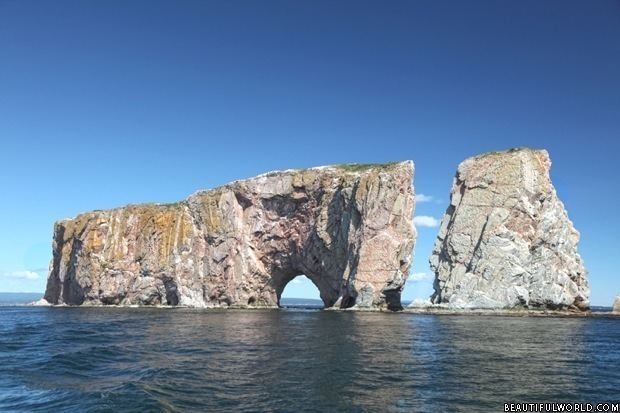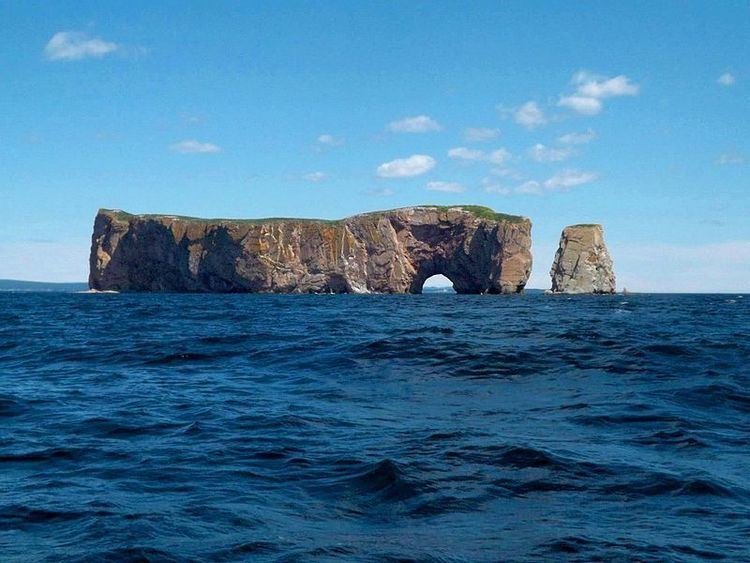Province Québec | Elevation 88 m | |
 | ||
Similar Bonaventure Island, Musée de la Gaspésie, Site d'Interprétation micmac d, Manoir Le Boutillier, Miguasha National Park | ||
Percé Rock (French Rocher Percé, "pierced rock") is a huge sheer rock formation in the Gulf of Saint Lawrence on the tip of the Gaspé Peninsula in Quebec, Canada, off Percé Bay. Percé Rock appears from a distance like a ship under sail. It is one of the world's largest natural arches located in water and is considered a geologically and historically rich natural icon of Quebec. It is a major attraction in the Gaspesie region.
Contents
- Map of PercC3A9 Rock PercC3A9 QC Canada
- Perc rock canada
- Etymology
- Legend
- Geography
- Description
- History
- In popular culture
- References
Map of Perc%C3%A9 Rock, Perc%C3%A9, QC, Canada
Perc rock canada
Etymology
The massive rocky cliff is called by several names, such as le Rocher Percé, Pierced Rock, Pierced Island, Split Rock or Percé Rock. The name is attributed to the pierced rock that formed an arch 15 metres (49 ft) high on its seaward southern end, as though a needle had cut through the rock. It was named Percé ("pierced rock") by Samuel de Champlain in 1607, in reference to the holes he had seen in the massive block of limestone, which over the years has become a major attraction in the region of Quebec.
Legend

The Percé Rock, described as "the monstrous giant; pierced through by an immense eye, now green, now gray, now blue or violet, according to the moods of the sea", is linked in legend to a young man of a noble French family. The legend associated with the young man, named Chevalier Raymond de Nerac, is that after his engagement to a lovely girl named Blanche de Beaumont, as an officer of the French army he was posted to a regiment in New France, despite wishing to stay in his familiar old world France. He was thus separated from his betrothed under expressed sentiments of loving each other for ever. He suffered pangs of separation as he traveled in Quebec. He was posted to the Fortress of St Louis and all his thoughts were of his betrothed. However, his fiancée also could not stand the separation and she decided to travel to Quebec with her uncle, to get married to her beloved. Unfortunately, as they approached Newfoundland they engaged in fierce battle on the seas with a Spanish pirate ship. Even though the French crew offered stiff resistance, they were all killed by the pirates and their ship was gutted. However, the girl in question who was hiding in the ship in one of the cabins was dragged out and brought before the pirate captain. As soon as he saw the beautiful girl, he fell in love with her and proposed marriage. He told her that she had no way of escape and that he would sail his ship even to the fort of St. Lawrence where she could probably have a glimpse of her fiancé. The girl, nonplussed, agreed, although her intentions were otherwise. At the time of marriage celebrations she suddenly jumped out into the deep sea and drowned. This created chaos on the deck of the pirate ship and the ship was covered with thick fog making sailing difficult, and any rescue operations difficult. The following morning, as the ship was anchored, the crew were facing a huge mass of rock, the Percé Rock, which appeared to be floating near the shore. The Spanish pirates were frightened by the massive rock which appeared in a "veiled appearance in which they thought they recognized Blanche de Beaumont". They saw the girl raise her hand in "malediction". When they tried to turn the ship to avoid it hitting the rock, the apparition disappeared and the ship crashed. Next day morning people who watched from the shores saw a rock had emerged in the place of the ship, off the Cape Rosier. The rock appeared like a "large vessel under sail". The local fishermen still say that the gentle spirit of the Blanche De Beaumont haunts the great Perce Rock, two hundred years after the girl drowned there. After this incident, the young man also died out of shock.
Another version of the legend, which is also narrated by the local people of Percé town, is that they see the rock in the shape of a "phantom" during storms and hence call it "Le Génie deľisle Percé". This, however, could be interpreted to mean that the vapoury clouds that engulf the "vast flocks of water fowl" could give such an impression when viewed from a distance.
Geography
Percé Rock is part of the range of cliffs, bays and hills on the SW side of Mal Bay, which are formed of reddish-gold limestone and shale. It is linked to mainland (at Rue du Mont Joli) by a sandbar at low tide. The Bay of Perce is situated between this rock and the High Head. There is a reef to the SW of Percé Rock, about 0.5 miles (800 m) away from the shore. The town of Percé is located on the shores of the bay. Its main industry is fishing. Percé reef is about 0.5 miles (800 m) from the centre of the town where small vessels can be moored. Midway across the rock is a shoal that stretches over a length of 0.25 miles (400 m).
The rock formation has about 150 fossil species. In Bonaventure Island where the park is situated, conglomerates from the Carboniferous period of more than 310 million years are recorded.
Next to the rock is Bonaventure Island, and together they form Parc national de l'Île-Bonaventure-et-du-Rocher-Percé (Bonaventure Island and Percé Rock National Park), founded in 1985, which covers an area of about 5.8 square kilometres (2.2 sq mi). The tip of the Gaspé Peninsula has five geological formations, and Percé Rock is the only one located within the park. The park extends over a 2 kilometres (1.2 mi) stretch of the coastline, and exhibits a wide variety of flora and fauna. It is a migratory bird sanctuary for the northern gannet, and has over 110,000 nesting birds, the second largest in the world. (The Municipal website of Percé mentions that the population of Northern gannets is 121,000, which exceeds the figures mentioned for the archipelago of St Kilda in Scotland)- Other birds found on the island include puffins, razorbills, black guillemot and kittiwakes, as well as over 200 other species. From May to December, some species of blue whale, humpback whale, minke whale or fin whale can be seen along the coast near Percé, Bonaventure Island and Forillon National Park.
At low tide, the rock is approachable on foot. The rock and the bird colony in Bonaventure Island is about a 75-minute trip from Percé by boat. Visits to the rock are restricted to the period from May 28 to October 12. During such visits, park guides provide information on beach creatures, the geology of Percé Rock, also called the "cathedral of limestone that rose from the Equator", and the fossils found there. The rock mass is a monolith estimated at 5 million tonnes. It has been inferred that at the current erosion rate (about 300 tonnes of mass per year lost to the action of water and wind), it will disappear in about 16,000 years. In view of its tendency to collapse, it is dangerous to venture close to the rock on foot during low tide. The top of the rock is not accessible. Snowy gannets, silvery gulls, black cormorants and other species of birds perch there.
An interpretation centre in Percé, housed in Le Chafaud, an elegant restored building, has a thematic exhibition titled "Un rocher, une île, un parc national", meaning "one rock, one island, one national park", which recounts the bird life, marine life, geology, history and ecosystem of the park and the rock.
Description
Percé Rock is a massive siliceous limestone stack formation, with sandstone and siltstone veins, with steep rock faces on all sides. It is 433 metres (1,421 ft) long, 90 metres (300 ft) wide, and 88 metres (289 ft) high at its highest point. It is described as a narrow bluff emerging out of the sea, "resembling a bleached supertanker from some angles". For four hours at a time during low tide, the water recedes from a wide spit that allows the rock itself to be visited.
History
Percé Rock's huge limestone formation is geologically dated to the Devonian period of more than 400 million years ago (375 million years is also mentioned). However, Percé Rock is only a small component of the large areas of Devonian rocks that occupy the interior that were first mapped in 1844 by Sir William Edmond Logan, known as the father of Canadian geology. Fossils in such rocks show a variety of animal and plant communities from both terrestrial and marine habitats from the Devonian period. The Percé Rock contains 150 species of different fossils such as brachiopod, trilobites, dalmanites, corals and marine worms from the Devonian period.
Originally, the Percé Rock was inferred as connected to the main land. When Jacques Cartier, the first colonist arrived here in 1534, he reported three arches in the massive rock formation. In time, two of the arches disappeared, with the last one collapsing on June 17, 1845, leaving a separated pillar. When it was seen in 1603 by the French geographer and founder of Quebec City, Samuel de Champlain, it had only one arch. However, in 1760, a picture of Percé Rock drawn by an English officer, Captain Hervey Smyth, showed two arches, one of which collapsed in June 1845. Percé rock's two large holes were cut through by the sea waves. One of the holes seen now is an arch described as "gothic arch of rock", which is about 15 metres (49 ft) high. A small boat can pass through the arch during high tide. Of the two arches, the outer arch, which collapsed with great force in 1845, remains in the form of an "obelisk". In early 1900s, enchanted by the beauty of the Percé Rock, travellers started visiting the area of Gaspe, Percé and Bonaventure Island.
In popular culture
Percé Rock is a major tourist attraction in Quebec, with picturesque views of the rock from both Percé and nearby Bonaventure Island.
French surrealist poet André Breton (1896–1966) visited Gaspé in October 1944 and recorded his impressions of the visit in Arcanum 17, "a hymn of hope, renewal, and resurrection". The name of the poem stands for the 17th tarot card in the Major Arcana, called the Star, which symbolizes a woman pouring lunar forces into a mundane world and represents negative connotations of loss or abandonment of hope or bright prospects. During the visit, Breton was attracted to the Percé Rock and drew inspiration from it. In contrast to his unhappy personal life in war-torn Europe, the Rock provided him with the inspiration and reminder that "nature renews herself and that death is only transitory." He called Percé Rock a "razor blade rising out of the water, an image very imperious and commanding, a marvelous iceberg of moon stone ... to a distracted observer though to a common man it is just but a resting place of birds".
